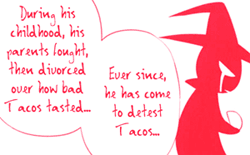S.B. Stewart-Laing's Blog
November 21, 2014
More Than The Sum of Their Powers
One of the fun things about speculative fiction is that you can create characters who have abilities far outside of our current human 'normal'. Our characters can be mutant superheros, aliens, vampires, genetically or technologically enhanced, or whatever else we can dream up. Given that this is so far outside the realms of our everyday experience that there's an immediate temptation to give your character some cool powers and leave it at that. This pattern is also true for characters whose main trait is 'being the chosen one' or 'the first/only X'.
I think one of the reasons people complain about the 'chosen one' trope is that this single title takes over the entire character, leaving little room for anything else. Now, if you have a character who was selected for this role at birth and spends their whole life preparing (think Ursula Le Guin's The Tombs of Atuan), that is another matter, as the process of the character's identity being totally consumed by their role is the focus of their character development.
For other characters, even if the character is born with the trait that makes them special, that trait is not the be-all end-all of their life experience. They will have a sense of their standing in socioeconomic class, their culture and ethnicity, their gender, their family relationships, and their role in the community among many other things. They will have their own personality, which may or may not mesh with the personalities of their friends, family and community, or with with the social expectations placed on them.
This is also important in terms of developing secondary characters. Particularly in genre fiction, these characters fill specific niches-- the love interest, the socially adept one, the one whose cool power balances out the main character. Thinking about the other key aspects of how this character views themselves (and how other characters may view them) gives these characters greater realism. It's also an excellent source of subplots, and keeps these characters from seeming creepily obsessed with the protagonist (unless, of course, one of these characters is a stalker-- in that case, carry on).
I think one of the reasons people complain about the 'chosen one' trope is that this single title takes over the entire character, leaving little room for anything else. Now, if you have a character who was selected for this role at birth and spends their whole life preparing (think Ursula Le Guin's The Tombs of Atuan), that is another matter, as the process of the character's identity being totally consumed by their role is the focus of their character development.
For other characters, even if the character is born with the trait that makes them special, that trait is not the be-all end-all of their life experience. They will have a sense of their standing in socioeconomic class, their culture and ethnicity, their gender, their family relationships, and their role in the community among many other things. They will have their own personality, which may or may not mesh with the personalities of their friends, family and community, or with with the social expectations placed on them.
This is also important in terms of developing secondary characters. Particularly in genre fiction, these characters fill specific niches-- the love interest, the socially adept one, the one whose cool power balances out the main character. Thinking about the other key aspects of how this character views themselves (and how other characters may view them) gives these characters greater realism. It's also an excellent source of subplots, and keeps these characters from seeming creepily obsessed with the protagonist (unless, of course, one of these characters is a stalker-- in that case, carry on).
Published on November 21, 2014 01:47
November 19, 2014
How Do You Identify?
 If I asked you to comment on this blog describing yourself, what would you say? Would you include your gender, your nationality, your occupation? What if you were describing yourself to a potential date or a potential colleague instead of a random blog-dweller?
If I asked you to comment on this blog describing yourself, what would you say? Would you include your gender, your nationality, your occupation? What if you were describing yourself to a potential date or a potential colleague instead of a random blog-dweller?Often, we think of our identity as something fixed and singular. We certainly talk about groups who share some common characteristic as though they were clones; we speak about 'the black experience' or 'the female experience' or whichever group we're discussing as through the were dots on a statistical model. But as much as I enjoy a good scatterplot, we are all unique experiential snowflakes who have many component parts to our self-identity. Furthermore, what we consider the most prominent or important piece of that multilayered description varies with our environment and continuing experiences.
When writing a character, it's easy to fall back into the habit of constructing identity as singular. The character has a single key feature-- culture, attractiveness, age, intelligence, or a cool superpower, and that's the fulcrum around which their personality and plot arc revolve (all other characteristics are presumed 'normal', which is a can of worms for another day). This is fine for walk-on characters, but for a major character it's worth investing time exploring the facets of their identity and how that character expresses themselves in different situations.
It is important to consider as well that a character's self-identity may differ from assumptions that other characters make, or features that other characters see as important (which gives you a chance to show some of the underlying power dynamics in your setting). Characters may hide parts of their identity, or be totally oblivious to parts of their identity that they see as a 'default', or perhaps they simply have different priorities than the other characters. Just working out some key points about how your character self-identifies and how they present themselves in different situations puts you a good portion of the way to developing a realistic and interesting character.
Published on November 19, 2014 01:44
November 17, 2014
It Makes Offense in Context
 Since I pre-schedule blog posts well in advance, I'm going to do this John Oliver-style and point out that about two weeks ago, the internet erupted in...lively debate... over a number of issues, ranging from ill-advised pyrotchnics to worse-advised overshares. What ties all of these incidents together is that those who had shared/lit fire to the offending material immediately fell back on the justification that it was 'just a joke' or that people needed to 'lighten up'. More interestingly, there was an outpouring of analogies: no one would be upset if it was X instead of Y! So why are people so upset about X?
Since I pre-schedule blog posts well in advance, I'm going to do this John Oliver-style and point out that about two weeks ago, the internet erupted in...lively debate... over a number of issues, ranging from ill-advised pyrotchnics to worse-advised overshares. What ties all of these incidents together is that those who had shared/lit fire to the offending material immediately fell back on the justification that it was 'just a joke' or that people needed to 'lighten up'. More interestingly, there was an outpouring of analogies: no one would be upset if it was X instead of Y! So why are people so upset about X?This seems like as good an opportunity as any to talk about the power of context. This is incredibly important for a writer to think about, both in terms of building their story-- what is the in-universe context of any given action or event?-- and in terms of how their story will be perceived by the audience-- that is, the context in which the story interacts with the world. When discussing either, you can divide 'context' up into two broad categories:
Immediate context. This is the intent of whoever is telling the joke or painting the painting or writing the screenplay or spraying the graffiti. In the moment of communication, this person has an intent. While intent can be meaningless once the piece of communication escapes into the wild (more on that in a moment), intent can be an important framework for interpreting the statement/painting/graffiti/movie-- immediate context is often the means by which one can differentiate satire from the real thing. There are also opinions we can articulate more easily in front of people who know us well and can 'fill in' nuance from that knowledge base, whereas expressing these opinions to a wider audience requires more finesse to establish the finer points of meaning for people whose only immediate context is what's right in front of them.Social/Historical context. This is the baggage a word, symbol, or action has acquired because of historical events, social trends, or collective cultural knowledge. Thus drawing former US President George Bush as a monkey is a cheap jibe at his competence, while depicting President Obama as a monkey carries the weight of hundreds of years of racism and violence against Africans and black Americans and is thus light-years more offensive. While the creators of such content can claim they didn't know, that's part of the problem: one group being systematically insulated from wrongs being suffered by another group, which brings us back to the point that creator intent has a limited effect on how people should or will interpret something.
The thing is, none of us can know everything, and all of us will open our mouths and insert our feet, no matter how hard we try. At the same time, the human inevitability of messing up and being offensive isn't a blank cheque for lazy research. Solid research about a topic should give you insight into the social and historical context, and should head off many potential problems at the pass.
Published on November 17, 2014 00:38
November 14, 2014
Maybe They're Born With It: Nature, Nurture, and Freudian Excuses, Part III
On the opposite end of the spectrum from the villain whose every action is explained by their awful childhood is the villain who is evil for no good reason. The prevailing explanation supported by the narrative is that they were just born evil (if the other characters merely think so, it doesn't count).
Real life is full of people whose actions are inexplicable to us, or strike us as deluded, evil, or bizarre. In general, we assume that this is some sort of immutable character trait in that individual: they're inherently mean, or a weirdo, or scheming, and there's nothing we can do about it. It usually doesn't occur to us-- at least not unless we deliberately make an effort to think about it-- that these people might be responding to a situation we don't know about, or behaving oddly relative to their usual conduct, or acting in a way that makes perfect sense according to their own internal logic. Psychologists call this phenomenon the 'fundamental attribution error', defined as 'people's tendency to place an undue emphasis on internal characteristics to explain someone else's behavior in a given situation, rather than considering external factors.'
When we write a villain who is distinctly the Other-- someone we cannot imagine identifying with, or imagine the reader identifying with-- the immediate urge is to write them as completely evil. We may not even be aware that we're doing so. Cognitive biases, by their nature, are subtle. And it's not out of line to have your characters exhibit these biases in-story. However, if the narrative itself-- the 'objective truth' of your universe and story-- supports the idea that the villain can be entirely explained by inborn evil tendencies, it strains credibility.
Yes, our baseline personalities do play a large role in how we behave. At the same time, environment is a key factor in shaping how those 'baseline' traits manifest-- we learn about socially acceptable and unacceptable behaviour; we learn about ways to use our strengths or compensate for weaknesses; we have different resources for meeting our needs. Biologists refer to this interaction between underlying propensities and the environment as 'GxE' (genetics x environment), because these factors that shape us are so entwined.
We don't have to empathise with the villain, or excuse their actions, in order to give them character depth. Their actions must run on some sort of internal logic, even if it's logic the audience will find repulsive. It also needs to be logic that connects to the setting and the character's personal experiences. That way, no matter how unsympathetic your villain is, or how awful their actions, they seem like a coherent, credible character.
Real life is full of people whose actions are inexplicable to us, or strike us as deluded, evil, or bizarre. In general, we assume that this is some sort of immutable character trait in that individual: they're inherently mean, or a weirdo, or scheming, and there's nothing we can do about it. It usually doesn't occur to us-- at least not unless we deliberately make an effort to think about it-- that these people might be responding to a situation we don't know about, or behaving oddly relative to their usual conduct, or acting in a way that makes perfect sense according to their own internal logic. Psychologists call this phenomenon the 'fundamental attribution error', defined as 'people's tendency to place an undue emphasis on internal characteristics to explain someone else's behavior in a given situation, rather than considering external factors.'
When we write a villain who is distinctly the Other-- someone we cannot imagine identifying with, or imagine the reader identifying with-- the immediate urge is to write them as completely evil. We may not even be aware that we're doing so. Cognitive biases, by their nature, are subtle. And it's not out of line to have your characters exhibit these biases in-story. However, if the narrative itself-- the 'objective truth' of your universe and story-- supports the idea that the villain can be entirely explained by inborn evil tendencies, it strains credibility.
Yes, our baseline personalities do play a large role in how we behave. At the same time, environment is a key factor in shaping how those 'baseline' traits manifest-- we learn about socially acceptable and unacceptable behaviour; we learn about ways to use our strengths or compensate for weaknesses; we have different resources for meeting our needs. Biologists refer to this interaction between underlying propensities and the environment as 'GxE' (genetics x environment), because these factors that shape us are so entwined.
We don't have to empathise with the villain, or excuse their actions, in order to give them character depth. Their actions must run on some sort of internal logic, even if it's logic the audience will find repulsive. It also needs to be logic that connects to the setting and the character's personal experiences. That way, no matter how unsympathetic your villain is, or how awful their actions, they seem like a coherent, credible character.
Published on November 14, 2014 00:55
November 12, 2014
'My Childhood Made Me Do It': Nature, Nurture & Freudian Excuses, Part II
If you are a regular reader of writing advice, I'm sure you've been told to make sure your villain 'isn't one-dimensional' or to 'round them out'. The main point of this-- that villains should be fully developed characters with motives that the audience can understand-- is a laudable one. A well-developed villain will give your protagonist something to struggle against, and a truly sympathetic villain can be a deeply tragic figure. However, there are also a number of ways that good intentions in villain development get derailed. One of these is explaining (and implicitly, excusing) the villain's behaviour by blaming it on a bad childhood (or worse, a single incident in their childhood) or traumatic recent past.
Done with sufficient finesse, this trope can actually work, particularly if the audience is shown how close the villain came to taking a different path, or that external events did profoundly shape their character in a way over which they had little control. Done without finesse or gravitas, it makes the villain seem petty and obsessed with trivial slights. At worst, it comes off as excusing, rather than explaining, the villain's actions, especially if it's framed as the reason we're supposed to sympathise with them (Save Wiyabi Project founder Lauren Chief Elk calls this phenomenon 'abuser coddling'). The 'coddling' aspect can be more grating when this trope is used with antiheroes (or heroes with a 'dark and troubled past') to excuse unheroic behaviour; however, because villains are often doing something intentionally harmful, it's harder to ask the reader to sympathise based on Pavlovian cause-and-effect psychology.
Doing this trope correctly requires the writer to probe the balance between nature-- in this case, the villain's baseline personality, and their personal choices-- and nurture-- the external forces that contributed to those choices. Making a villain a well-developed character doesn't mean we have to feel sympathy for them, we just need their motives to be believable.
Done with sufficient finesse, this trope can actually work, particularly if the audience is shown how close the villain came to taking a different path, or that external events did profoundly shape their character in a way over which they had little control. Done without finesse or gravitas, it makes the villain seem petty and obsessed with trivial slights. At worst, it comes off as excusing, rather than explaining, the villain's actions, especially if it's framed as the reason we're supposed to sympathise with them (Save Wiyabi Project founder Lauren Chief Elk calls this phenomenon 'abuser coddling'). The 'coddling' aspect can be more grating when this trope is used with antiheroes (or heroes with a 'dark and troubled past') to excuse unheroic behaviour; however, because villains are often doing something intentionally harmful, it's harder to ask the reader to sympathise based on Pavlovian cause-and-effect psychology.
Doing this trope correctly requires the writer to probe the balance between nature-- in this case, the villain's baseline personality, and their personal choices-- and nurture-- the external forces that contributed to those choices. Making a villain a well-developed character doesn't mean we have to feel sympathy for them, we just need their motives to be believable.
Published on November 12, 2014 02:37
November 10, 2014
A Victim of Life's Circumstances: Nature, Nurture & Freudian Excuses, Part I
 In most stories, it's a given that the audience is supposed to connect with the protagonist and cheer for their efforts. This doesn't mean, by any stretch, that the hero is squeaky clean. Rather the 'dark and troubled past' and the subsequent brooding by the hero has become almost expected, especially in certain genres. I have no objections to this trope in and of itself; in fact, in some settings and genres it comes off as creepy and unrealistic if the protagonist seems to have no psychological upset from their upbringing or from traumatic events that occur over the course of the story.
In most stories, it's a given that the audience is supposed to connect with the protagonist and cheer for their efforts. This doesn't mean, by any stretch, that the hero is squeaky clean. Rather the 'dark and troubled past' and the subsequent brooding by the hero has become almost expected, especially in certain genres. I have no objections to this trope in and of itself; in fact, in some settings and genres it comes off as creepy and unrealistic if the protagonist seems to have no psychological upset from their upbringing or from traumatic events that occur over the course of the story.People have a whole variety of reactions to surviving horrible events, and that depends on a mixture of their personality, the specific circumstances of their experience, and social customs and expectations. It's true that many people react by 'acting out' in some way. However, there are several issues I would like to unpick about how this trope is currently used.
First, the Dark and Troubled Past gets heavily romanticised. The fact that the character is brooding, emotionally unstable, and stewing over everything that's awful in their life (or was awful in their life) is portrayed as 'cool'. In reality, it's no fun to live inside that person's head, and other characters aren't going to flock to the 'cool' and 'mysterious' angsty character (some with the view of fixing them). Instead, they'll most likely take the character's 'leave me alone' or 'I don't want to talk' outbursts or generally antisocial demeanor at face value, and go away.
(Aside: if your reaction to this is 'but they have PTSD, it's not their fault!', then go read up on the clinical features of PTSD and write a character who has it, not use the condition as a catch-all phrase for angst.)
Second, the character stays stuck in their angst. This trope is most prominent when the traumatic event (or worse, not-so-traumatic event) happened far into the character's past. This isn't to say they should have 'gotten over' whatever the event was, but rather that over the intervening time they have most likely developed many coping mechanisms to deal with their feelings and function in day-to-day life and social interactions. They may have done some genuine healing in the intervening time. Again, if your character is having a pathological reaction, and the narrative identifies it as such, that's different.
Finally, there is something exploitative about giving a character a traumatic past for easy sympathy points. This goes double for writers who haven't experienced any serious trauma and have no perspective on how to write about such experiences, or the character's reactions, realistically (no, 'too much orange zest in my mimosa' doesn't count). If you're committed to writing a character with such a backstory, then dive into primary sources and really develop that character as an individual. Don't just heap a bunch of suffering onto them and expect them to instantly become cool.
Published on November 10, 2014 02:40
November 7, 2014
When Money Grows on Trees
 I've praised J.K. Rowling's through world-building in the Harry Potter series before: her setting is remarkably detailed, with an impressive amount of backstory. The one thing that always bugged me, however, was the matter of economics. Since we've seen people transfigure random trash into household objects, magically mend shattered glasses, and manifest pasta sauce, there seems to be an extremely limited market for goods and services. There are niche craftspeople, certainly, but most of these are the stuff of infrequent purchases, so what is running the day-to-day economy? And furthermore, what value is gold when you can manifest tea cups out of the contents of your rat traps and tea out of thin air?
I've praised J.K. Rowling's through world-building in the Harry Potter series before: her setting is remarkably detailed, with an impressive amount of backstory. The one thing that always bugged me, however, was the matter of economics. Since we've seen people transfigure random trash into household objects, magically mend shattered glasses, and manifest pasta sauce, there seems to be an extremely limited market for goods and services. There are niche craftspeople, certainly, but most of these are the stuff of infrequent purchases, so what is running the day-to-day economy? And furthermore, what value is gold when you can manifest tea cups out of the contents of your rat traps and tea out of thin air?The problem of suspect economics isn't unique to the Potterverse by a long shot. Rowling at least gives us a banking system, a regulatory agency, and some credible specialist businesses. Many fantasy worlds seem to run on a completely nonsensical economic system. This is particularly prominent in worlds where magic users can basically manifest stuff for free (see my pet peeve about magic having no consequences). If the economic system of your world is blatantly unworkable, it undermines suspension of disbelief.
The economy doesn't have to be described in great detail, nor do you need to dive deep into competing economic theories. Your fictional economy just has to be credible. Humans have used all kinds of economic systems over time, to varying degrees of success, so there are plenty of plausible examples to borrow from when you create your world. Since you're looking for conflict, the economy doesn't necessarily have to be in good shape-- perhaps there's economic stagnation, or there's been a recession, or there's massive wealth inequality. But some key things to work out:
What are staple goods in your society?How are those goods produced? Who produces them?Are there any high-demand goods that are driving an industry boom? If so, what are they?What goods (if any) does your society import and export? If so, how do these goods travel?Does your society use currency?What are the skilled goods and services in your society?Is there wealth inequality? Or is your society collectivist? If there is wealth inequality, how did it happen and how is it maintained?What are the status symbols and luxury goods, if any, in your society?
The answers to these questions can be fertile ground for creating a plot form your setting, or a rich source of complications for your existing plot. At the very least, you'll have created a more completely developed world for your audience to enjoy.
Published on November 07, 2014 02:57
November 5, 2014
Join the Dark Side, Our Trains Run On Time; or It's Bonfire Night, Let's Talk Extremism
 I'm going to hazard a guess that if Voldemort appeared in your home town with a signup sheet, you probably wouldn't reach for your pen. In fact, I'd bet the majority of you would hear his first few agenda items and slam the door in his noseless face.
I'm going to hazard a guess that if Voldemort appeared in your home town with a signup sheet, you probably wouldn't reach for your pen. In fact, I'd bet the majority of you would hear his first few agenda items and slam the door in his noseless face. If that sounds like you, you're clearly not the average citizen of Fantasyland. Typical Dark Lords seem able to gather an army in no time at all-- and not just foot soldiers who got bullied into the job, but genuine supporters. Never mind that there's nothing currently wrong with their lives or their country, they're going to help the Dark Lord burn it down anyway. Because evil. Or because insanity (which I find to be a huge authorial cop-out). As far as motives go, I find this unrealistic and a bit jarring.
In real life, fascism doesn't appear in a vacuum, fueled by the sheer force of evil. People who are reasonably content with their lives, or see an outlet for addressing their problems, are unlikely to want to trash the status quo. Even a quick perusal of the rise of historical dictators and fascist movements around the world shows such movements build momentum based on deep-seated social discontent. In a world where the economy is unraveling, or disease is spreading wildly, or the environment is changing, and people feel they've lost control, the easy answer is to point to an easy target and direct everyone's frustration into enraged action.
Essentially, such an extremist movement needs two main 'talking points' to gain any kind of traction. First, there needs to be an enemy, who are the purported source of the problem. This talking point is all about rage (frustration with what is currently broken) and fear (that the enemy will make the problem worse). Second, there needs to be a game plan for making things better. For maximum effect, this isn't just about exterminating the enemy. It's a grand vision for the future, for meeting peoples' needs and wants.
In the context of speculative fiction and worldbuilding, that means you the author need to establish two key features of your setting:
1) A systemic inequality or source of public outrage, social problems, etc. This should be a complex problem, otherwise the extremists have a point. The agitators will either be at the receiving end of the injustice and feel they have identified a singular cause to be eliminated, or perceive themselves to be the recipients of injustice.
2) Some cool temptation with which to lure in new recruits. In Susan Cooper's The Dark is Rising series, the Dark offers instant gratification; other temptations include elevated social status in the promised new order, cool forbidden powers, or riches stolen from the enemy. Whatever this is, it has to have strong appeal.
If you make your extremist movement part of your setting, rather than plopping it in willy-nilly, it will serve as a much more formidable force for your protagonists to defeat.
Published on November 05, 2014 02:33
November 3, 2014
The Fixer-Upper
 We've long established that there's no therapists in Fictionland, or at least no one with the requisite income or whose job includes health insurance. For a surprising number of characters, this doesn't seem to be a problem: just find a love interest (usually female) and they'll patch you right up! No matter what a disaster zone the character is, or how poorly they treat their partner, all will be solved and forgiven by the power of True Love.
We've long established that there's no therapists in Fictionland, or at least no one with the requisite income or whose job includes health insurance. For a surprising number of characters, this doesn't seem to be a problem: just find a love interest (usually female) and they'll patch you right up! No matter what a disaster zone the character is, or how poorly they treat their partner, all will be solved and forgiven by the power of True Love.In Fictionland, the damaged character is a fixer-upper, just waiting for the right person to come along and make it all better. Now, I generally believe that good relationships change the participants for the better, even if the relationship ultimately doesn't last. And we lean on our partners when the going gets tough, often with a greater intensity that we lean on our other support systems. But the Fictionland version goes beyond a deeply supportive partnership and borders on one character being a wreck, whilst the other takes the job of cleaning up after them.
Obviously, this dynamic exists far too often in real life. People of all genders, ages, cultures, sexual orientations, etc. get tangled up in unhealthy relationships for all kinds of reasons. If your story shows the relationship as being dysfunctional-- that is, the reader is supposed to watch the couple's interactions and cringe-- that's one thing. My peeve is about authors who write about what is, bluntly, a toxic relationship, and either normalise or romanticise the behaviour they describe. There are three main messages here:
True love/TLC/general doormat behaviour fixes the jerkass partner. Implied: if the victim showers the abuser with affection and they're still behaving abominably, the victim didn't try hard enough, and the behaviour is thus the victim's fault. This trope hits women particularly hard because of the Victorian-era concept that women were naturally nurturing, and thus meant to reform and 'civilise' their naturally depraved male partners.The scary/controlling/manipulative/violent behaviour means they are just super-duper in love! The message here is that whatever awful thing the person is doing is actually a romantic gesture (seriously, what happened to candlelit dinners and long walks on the beach?) and the victim should return the affection.The dysfunctional couple is normal/healthy/totally in love. This tells us that it's normal (and even good) for a relationship to include partners stalking, spying, getting cut off from friends/family/support systems, screaming rage, etc. Not exactly the narrative we want for our society, especially given the disturbing percentage of youngsters for whom fictional media is their main purveyor of sex ed/relationship advice.
I'm not telling you not to write characters whose romantic relationships are a horrific mess. Just don't write a horrific mess and call it tender romance.
Published on November 03, 2014 01:41
October 31, 2014
Samhainn Mhath Dhuibh!
 Happy Halloween, everyone!
Happy Halloween, everyone!For thousands of years, my Celtic ancestors have marked the turnover between the 'light' and 'dark' halves of the year, a night when ghosts and other supernatural beings were free to roam among humans.
This lack of a barrier between the world of supernatural and the mundane continues through November 1st (sometimes called All Soul's Day). This is the origin of the phrase 'a year and a day' that turns up in lots of Celtic or Celtic-influenced folklore: it was one year, plus All Soul's Day.
Halloween has historically been both a harvest festival and an attempt to appease any supernatural creatures that might be wandering about. A number of traditions developed around these goals:
Children went house-to-house, soliciting fuel contributions for a large bonfire. Often, the bones of animals that had been slaughtered to provide food for the winter were placed in the fire. Later, the ashes were scattered;Food was left out on doorsteps to appease any restless spirits or supernatural creatures that might be out and about;Dressing up in costumes, including cross-dressing or dressing up as animals or spirits, symbolised the breakdown of boundaries. Jack-o-lanterns were carved from vegetables to imitate the faces of supernatural creatures.Ritual redefinition of property boundaries and public paths, claiming the space for humans.
Over time, these evolved into the recognisable modern Halloween traditions that have been spread through the world by mass immigration and, more recently, mass media.
Published on October 31, 2014 03:27



